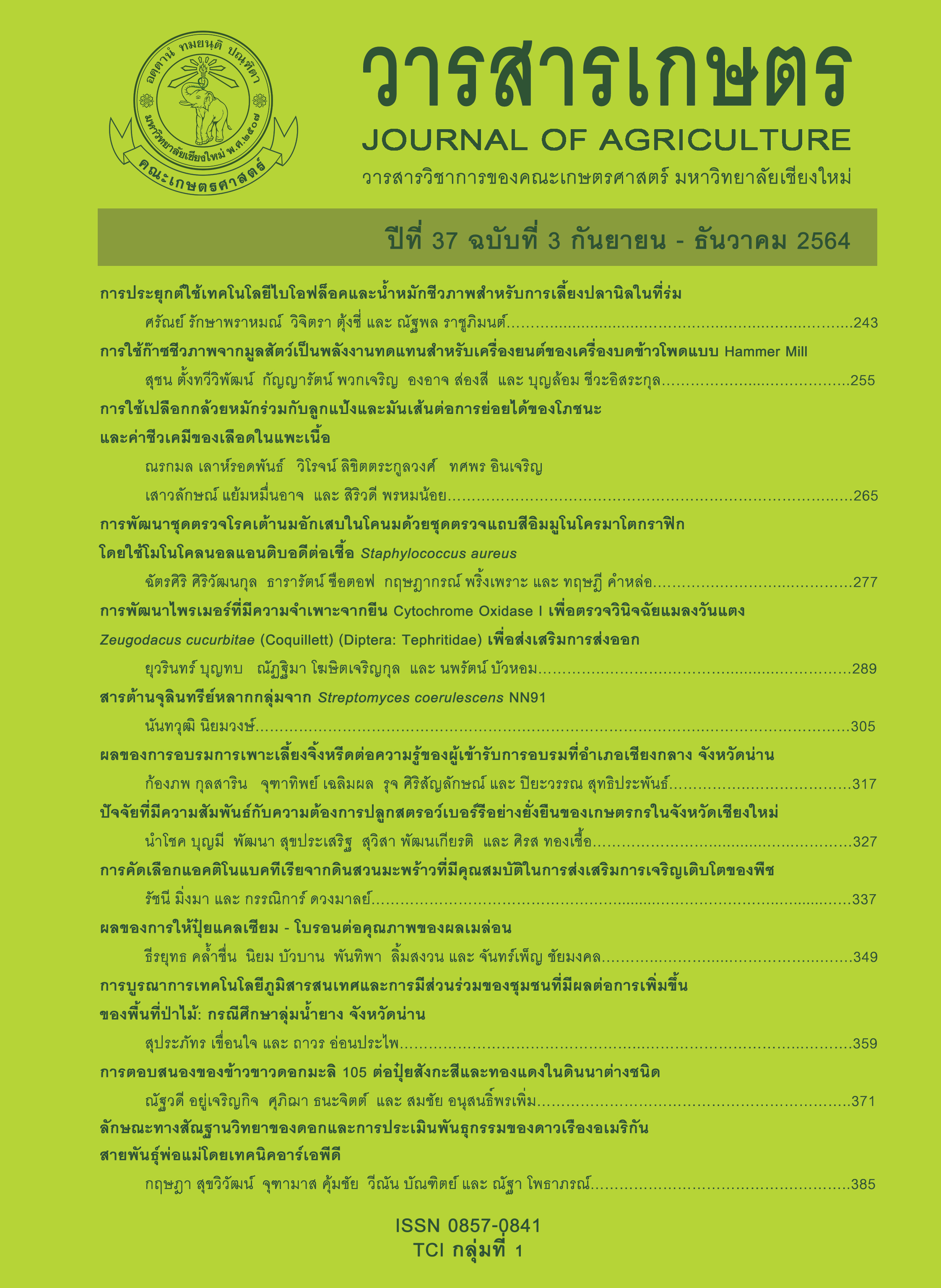การพัฒนาชุดตรวจโรคเต้านมอักเสบในโคนมด้วยชุดตรวจแถบสีอิมมูโนโครมาโตกราฟิกโดยใช้โมโนโคลนอลแอนติบอดีต่อเชื้อ <I>Staphylococcus aureus</I>
Main Article Content
บทคัดย่อ
งานวิจัยนี้มีวัตถุประสงค์เพื่อพัฒนาชุดตรวจแถบสีสำหรับระบุเชื้อก่อโรคเต้านมอักเสบในน้ำนมดิบของแม่โค อาศัยเทคนิคภูมิคุ้มกันวิทยาโดยใช้โมโนโคลนอลแอนติบอดีต่อเชื้อ Staphylococcus aureus ทำการทดสอบความจำเพาะเจาะจงของโมโนโคลนอลแอนติบอดีต่อเชื้อ S. aureus และทดสอบการเกิดปฏิกิริยาข้าม ในเชื้อก่อโรคเต้านมอักเสบกลุ่มอื่น ๆ ได้แก่เชื้อ Enterococcus faecalis, Streptococcus agalactiae และ Escherichia coli ด้วยเทคนิคอินไดเรคเอนไซม์ลิงค์อิมมูโนซอร์เบนท์เอสเซ (indirect enzyme-linked immunosorbent assay: indirect - ELISA) ที่จำนวนเชื้อก่อโรค 106, 107, 108 และ 109 CFU / mL พบว่า ระดับความเข้มข้นของโมโนโคลนอลแอนติบอดีที่เหมาะสมในการทำปฏิกิริยาคือ 1: 2,500 สามารถจับกับเชื้อ S. aureus, E. faecalis, S. agalactiae และ E. coli ที่จำนวนเชื้อ 109 CFU/mL ได้เท่ากับ 100, 30, 13 และ 10 % ตามลำดับ เมื่อนำโมโนโคลนอลแอนติบอดีพัฒนาเป็นชุดตรวจแถบสี โดยนำมาติดฉลากกับ colloidal gold ขนาด 40 nm (pH 9.0) สามารถเชื่อมติดกันได้สูงสุดที่ค่าการวัดดูดกลืนแสง 532 nm จากนั้นนำโมโนโคลนอลแอนติบอดี ความเข้มข้น 1 mg / mL ปริมาตร 0.5 µL หยดบนแผ่นกระดาษไนโตรเซลลูโลสเมมเบรน ที่ตำแหน่งทดสอบ และหยด goat anti - mouse IgG (H + L) ความเข้มข้น 0.8 mg / mL ปริมาตร 0.5 µL ที่ตำแหน่งควบคุมปฏิกิริยา จากนั้นนำชุดตรวจมาอบแห้งที่อุณหภูมิ 37 ºC นาน 14 - 16 ชั่วโมง หลังจากประกอบชุดตรวจทดสอบสำเร็จ จึงนำชุดตรวจไปทดสอบด้วยการหยดตัวอย่างเชื้อก่อโรคชนิดต่าง ๆ ที่จำนวน 109 CFU / mL ในสารละลายบัฟเฟอร์ พบว่า เฉพาะตัวอย่างที่มีเชื้อก่อโรค S. aureus แสดงแถบสีชมพูม่วง ในตำแหน่งควบคุมและตำแหน่งทดสอบ ขณะที่เชื้อก่อโรคชนิดอื่นแสดงแถบสีชมพูม่วงในตำแหน่งควบคุมเท่านั้น ดังนั้นชุดตรวจระบุเชื้อก่อโรคเต้านมอักเสบที่พัฒนาขึ้นนี้เป็นชุดทดสอบที่มีความจำเพาะต่อ S. aureus และใช้เป็นชุดตรวจต้นแบบในระดับห้องปฏิบัติการเพื่อระบุการติดเชื้อ S. aureus ที่รวดเร็วสำหรับวินิจฉัยเชื้อก่อโรคเต้านมอักเสบได้
Article Details
เอกสารอ้างอิง
Barkema, H.W., Y.H. Schukken, T.J.G.M. Lam, M.L. Beiboer, H. Wilmink, G. Benedictus and A. Brand. 1998.
Incidence of clinical mastitis in dairy herds grouped in three categories by bulk milk somatic cell counts. Journal of Dairy Science 81(2): 411-419.
Belkessam, Y., M. Benali, S. Moulessehoul and D. Harrach. 2010. Polyclonal antibodies production against Staphylococcus aureus protein A: ELISA technique optimization for milk quality control. African Journal of Biotechnology 9(5): 764-769.
Boerlin, P., P. Kuhnert, D. Hüssy and M. Schaellibaum. 2003. Methods for identification of Staphylococcus aureus isolates in cases of bovine mastitis. Journal of Clinical Microbiology 41(2): 767-771.
Guidry, A.J., K.E. Squiggins, W.F. Vann and D.C. Westhoff. 1991. Prevention of nonspecific binding of immunoglobulin to Staphylococcus aureus protein A in ELISA assays. Journal of Immunological Methods 143(2): 159-165.
Guo, H., Y.H. Yuan, C. Niu, Y. Qiu, J.P. Wei and T.L. Yue. 2018. Development of an indirect enzyme-linked immunosorbent assay for the detection of osmotolerant yeast Zygosaccharomyces rouxii in different food. Food and Agricultural Immunology 29(1): 976-988.
Hamann, J. 2010. Mastitis and raw milk quality, safety and yield. pp. 246-263. In: M.W. Griffiths (ed.). Improving the Safety and Quality of Milk: Milk Production and Processing. Woodhead Publishing Ltd., Oxford.
Leelahapongsathon, K., Y.H. Schukken and W. Suriyasathaporn. 2014. Quarter, cow, and farm risk factors for intramammary infections with major pathogens relative to minor pathogens in Thai dairy cows. Tropical Animal Health and Production 46(6): 1067-1078.
Niu, K., Z. Xiaoping, H. Chusen, X. Kuan, Z. Yuan, S. Hebai and J. Nengqin. 2014. A colloidal gold nanoparticle-based immunochromatographic test strip for rapid and convenient detection of Staphylococcus aureus. Journal of Nanoscience and Nanotechnology 14(7): 5151-5156.
Pumipuntu, N., S. Kulpeanprasit, S. Santajit, W. Tunyong, T. Kong-Ngoen, W. Hinthong and N. Indrawattana. 2017. Screening method for Staphylococcus aureus identification in subclinical bovine mastitis from dairy farms. Veterinary World 10(7): 721-726.
Sirinupongsanun, V. and N. Simasatitkul. 1997. Mastitis Prevention and Control: Expense, Milk Quality and Incidence of Mastitis. Journal of Agriculture 13(3): 193 - 200.
Sowmya, N., M.S. Thakur and H.K. Manonmani. 2012. Rapid and simple DNA extraction method for the detection of enterotoxigenic Staphylococcus aureus directly from food samples: comparison of PCR and LAMP methods. Journal of Applied Microbiology 113(1): 106-113.
Srisrattakarn, A., P. Tippayawat, A. Chanawong, R. Tavichakorntrakool, J. Daduang, L. Wonglakorn and A. Lulitanond. 2020. Development of a prototype lateral flow immunoassay for rapid detection of staphylococcal protein A in positive blood culture samples. Diagnostics 10(10): 794, doi: 10.3390/diagnostics 10100794.
Tomás, A.L., M.P. de Almeida, F. Cardoso, M. Pinto, E. Pereira, R. Franco and O. Matos. 2019. Development of a gold nanoparticle-based lateral-flow immunoassay for Pneumocystis pneumonia serological diagnosis at point-of-care. Frontiers in Microbiology 10: 2917, doi: 10.3389/fmicb.2019.02917.
Tringe, S.G. and E.M. Rubin. 2005. Metagenomics: DNA sequencing of environmental samples. Nature Reviews Genetics 6(11): 805-814.
Upadhyay, N. and S. Nara. 2018. Lateral flow assay for rapid detection of Staphylococcus aureus enterotoxin A in milk. Microchemical Journal 137: 435-442.
Wiriyachaiporn, S., P.H. Howarth, K.D. Bruce and L.A. Dailey. 2013. Evaluation of a rapid lateral flow immunoassay for Staphylococcus aureus detection in respiratory samples. Diagnostic Microbiology and Infectious Disease 75(1): 28-36.


